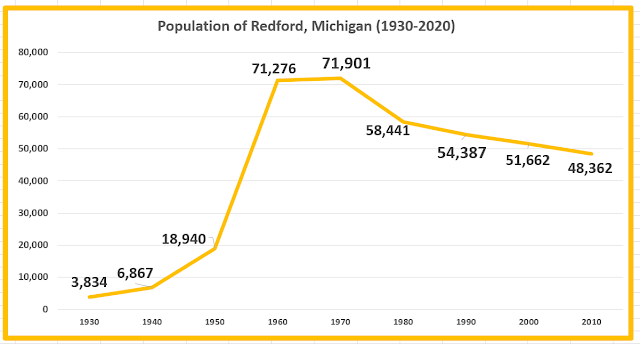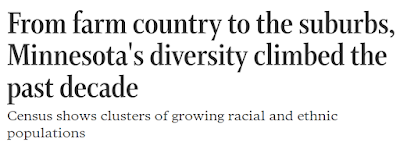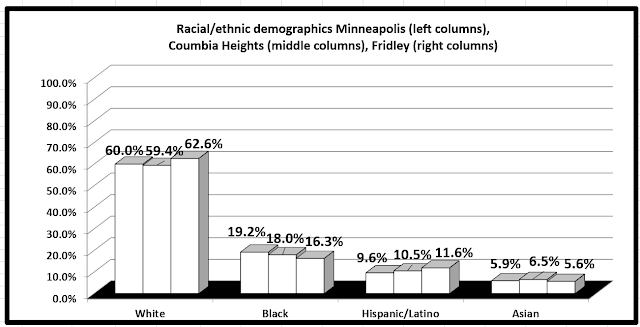Chicago/Cook County, Illinois
Skokie and Morton Grove are first-ring suburbs east and north/northwest of of The Loop.
Incorporated in 1888, Skokie experienced its biggest growth spurt during the 1950, when its population increased 300%. It peaked in 1970 but has been trending upward since 1990.
Incorporated in 1895, Morton Grove experienced its biggest growth spurt during the 1950, when its population increased more than 400%. It peaked in 1970 but has been trending upward since 1990.
While price was naturally a factor, a number of additional considerations tipped the scales in Skokie's favor. Infante, 37, says he and his wife were impressed with the school system and park districts. Demographics also mattered. "One of the things that's most important to me, being a minority myself, was having diversity for my kids, both ethnic and religious," says Infante, whose Cuban parents came here in 1971. With a large mix of immigrants -- in particular, more than one-fifth of Skokie's approximately 64,000 residents have Asian ancestry -- and a large Jewish population, "Skokie really sticks out in those aspects."
Detroit/Wayne County/Oakland County, Michigan
Southfield and Redford are first-ring suburbs east and northwest of Detroit.
U.S. Census Bureau QuickFacts
Incorporated as a city in 1958, Southfield's growth exploded during the 1950s and 1960s. Its population peaked in 1980 and has been treading water ever since.
What distinguishes Southfield from other suburbs, however, is that its economic growth coincided with demographic change as more people of color, especially African Americans, moved there. In 1970, less than one percent of Southfield's residents were black. Today, 70 percent of the city is African American, 25 percent is white, and the rest is a mix of Latino, Native American, Asian, and multiracial families. Over 36 percent of residents hold at least a bachelor's degree (the national average is just under 29 percent, while the state of Michigan's is less than 26 percent). Median household income is $49,841, making it one of two majority-black cities in Michigan with a higher median household income than that of the state of Michigan. (Lathrup Village, an enclave city of Southfield, is the other.) [emphasis added]
Cleveland/Cuyahoga County, Ohio, part 2
South Euclid and Garfield Heights are first-ring suburbs east and south of Cleveland.
Take one case study, in Garfield Heights, where the population grew by nearly 1,000 to 29,781 – exclusively attributable to people of color. While the white population decreased by 38%, the number of Black residents increased by 63%. The Hispanic population nearly doubled, and more than twice as many residents identify as multi-racial than in 2010.
Mayor Matt Burke said he was unsurprised to learn that his East side suburb has become increasingly diverse in the past decade. He has long observed the turnover from an older, white population to young families, many of them Black, brown or multi-racial, who are attracted to Garfield Heights’ affordable housing stock.
Cleveland/Cuyahoga County, Ohio, part 1
Euclid and Cleveland Heights are first-ring suburbs east of Cleveland.
Related reading:
St. Louis/St. Louis County, Missouri, part 3
Florissant and Hazelwood are first-ring suburbs northwest of St. Louis.
Florissant experienced a boom during the 1950s and 1960s. Its population peaked in 1970, then declined a bit and is now levelling off.
Incorporated in 1949, Hazelwood experienced its first growth spurt in the 1950s and 1960s. Then it took a breather before another spurt took place in the 1990s.
This is not your grandpa’s St. Louis.
Following a national trend, the St. Louis metro area continues to diversify, according to the most recent census data, released this month. Nonwhite populations skyrocketed over the last decade, from St. Charles to Madison counties. Asian and Hispanic communities grew regionwide. And, in a place that has long defined itself as either white or black, the number of white residents and Black residents tumbled by thousands each.
St. Louis/St. Louis County, Missouri, part 2
University City and Overland are first-ring suburbs west of St. Louis.
University City experienced it largest population growth during the 1920s and 1950s. Its population peaked in 1960 and has decreased 32% since then.
Incorporated in 1939, Overland experienced its largest population growth during the 1940s and 1950s. Its population peaked in 1970 and has decreased 38% since then.
Related reading:
This area’s second superhighway, known as the Third Street Expressway, opened in 1955 from the riverfront to Gravois Avenue at 12th Street. It ran all of 2.3 miles. Viewed by today's standards, it was quaintly obsolete from day one.
St. Louis, crammed with 856,700 residents in 1950, was losing 200 each week to new subdivisions eight and more miles beyond the Third Street Expressway’s reach. Suburban growth, slow during the Depression and World War II, exploded as people abandoned 15 years of deprivation and crowded city apartments in a rush for the good life.
Thus the booms in babies and new single-family homes surrounded by grass. St. Louis County’s population was 274,200 people when the war began. By 1960, it would top 700,000 and keep climbing.
St. Louis/St. Louis County, Missouri, part 1
Ferguson and Jennings are first-ring suburbs northwest of St. Louis.
Ferguson was incorporatedin 1894 but experienced it largest population growth during the 1950s and 1960s.
Ferguson was also dealing with a racially charged controversy. Residents of Kinloch, the city’s tiny all-black neighbor, wanted Ferguson to remove a barrier on its border that blocked a major avenue and prevented motorists from using it to drive into or out of Kinloch.
Ferguson Mayor John Brawley ordered the street opened in 1968, the same year Larman Williams became one of the first African Americans to buy a home in Ferguson. But a councilman’s efforts to build a 10-foot fence between the two communities — the so-called “Berlin wall” — would continue into the 1970s and make national headlines
New York Times, 11/18/2021
The suburban school is an imagined space that invites an unhealthy amount of hyperbole, misinterpretation and fear. All-white classrooms with a few token Asians, expansive, well-kept playing fields and pickup circles filled with Volvo S.U.V.s driven by anxious, potentially reactionary mothers might still exist in small pockets of the country. But even many of those privileged spaces have likely seen significant demographic change over the past few decades.
Millions of minority families have moved outside the country’s largest cities over the past 20 years. At the same time, the number of people in these areas who are living under the federal poverty line grew by 57 percent between 2000 and 2015.
St. Paul/Ramsey County Minnesota edition
Maplewood and Little Canada are first-ring suburbs north and east of St. Paul. (Not Maplewood's odd shape on the map below.)
Some cities and counties are diversifying much faster than others. Suburbs like Maplewood, North St. Paul, Landfall and Oakdale saw some of the biggest metro increases in their diversity index scores. That index measures the likelihood that two randomly selected people from a community would be different races and ethnicities.
[snip]
Maplewood Mayor Marylee Abrams said that in her 2 ½ decades living in the city, she has seen examples of increasing diversity "everywhere. Everywhere." In the local school district, two-thirds of students identified as a race other than white, or two or more races. At the Maplewood Mall, the number of businesses owned by people of color has climbed.
Minneapolis/Hennepin County edition, part 3
Richfield and Hopkins are first-ring western suburbs of Minnepolis.
Columbia Heights and Fridley are first-ring suburbs just north of Minneapolis.
People of color now make up nearly 24 percent of Minnesota’s 5.7 million residents, up from about 15 percent of the state population a decade ago. The demographic changes were driven by growing populations of Black, Asian, Hispanic and multiracial residents, while the number of white Minnesotans declined for the first time in state history.
Minneapolis/Hennepin County edition, part 1






















































No comments:
Post a Comment